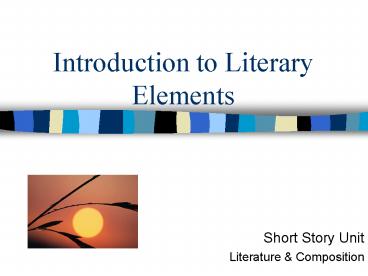Introduction to Literary Elements - PowerPoint PPT Presentation
1 / 16
Title:
Introduction to Literary Elements
Description:
Introduction to Literary Elements Short Story Unit Literature & Composition * Fiction Prose/narrative (story form writing) about imaginary people, places and events ... – PowerPoint PPT presentation
Number of Views:240
Avg rating:3.0/5.0
Title: Introduction to Literary Elements
1
Introduction to Literary Elements
- Short Story Unit
- Literature Composition
2
Fiction
- Prose/narrative (story form writing) about
imaginary people, places and events - Something that is made up--- not factual
- Can seem realistic
3
Plot
Climax
Rising Action
Falling Action
Exposition
Resolution (Denouement)
Turning Point (Inciting Incident)
4
Foreshadowing
- The use of clues or hints by the author to
prepare the reader for what will happen later - Can use background information, mood music
5
Conflict
- Character vs. Character
- Character vs. Society
- Character vs. Self
- Character vs. Nature
- Character vs. Technology/Machine
- Character vs. Supernatural/Deity
6
Characterization
- What the character says
- What the character does
- What the character thinks/feels
- What other characters say think about him/her
- The characters physical appearance or
environment
7
Dynamic Characters
- Those who transform or evolve in the story
usually major characters
Static Characters
- Those who do NOT change or grow, but remain the
same usually minor characters
8
Protagonist
- The character with whom the reader is meant to
sympathize - The character who grows or learns something
- Often the hero
9
Antagonist
- The character (or force) who stands in conflict
with the protagonist - Often the villain
10
Setting
- Time/When
- Place/Where
- Social Atmosphere (affected by historical
era, social movements, and crises)
11
Tone
- The authors attitude toward
- his/her subject
- Emotion words are used to label
- this element in a story (e.g.
- angry, indifferent, excited, sad)
12
Mood / Atmosphere
- The readers emotional response to the
characters and events of a story - Often influenced by setting and tone
- Emotion words also used here
13
Symbols
- Concrete objects that suggest abstract ideas
- Something that stands for something else
- For example red roselove
14
Point of View Perspective
- First person narrator is a character in the
story (I perspective) can be unreliable! - Third person limited story is told through the
thoughts feelings of ONE character - the reader
may feel like she is looking over the shoulder
of a character (S/heperspective) - Third person omniscient narrator is NOT a
character in the story story is told from a
god-like perspective can relate knowledge about
all characters at any time
15
Irony
- Situational when the opposite of what is
expected occurs - Verbal when a character says one thing but
means another (the opposite) - Dramatic when the audience/reader knows
something that a character does not know
16
Theme
- The universal truth revealed about life
- Must be stated in a complete sentence
- Avoids using clichés, giving advice or stating a
rule































